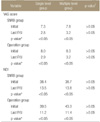Abstract
Purpose
The purpose of this study is to assess the 5-year outcome of patients considering surgery for complaint of cervical and radiating pain treated by selective nerve root block (SNRB).
Materials and Methods
Between January 2001 and December 2007, 39 cases were selected from patients who underwent SNRB before the operation and were followed-up for more than five years. The mean follow-up period was 64.3 months and the mean age was 57.7 years. The patients were divided into the operation group and the only cervical SNRB group. The groups were compared for gender, age, duration, disease, single or multi-level, and root compression rate on magnetic resonance imaging. The clinical results were analyzed using the neck disability index (NDI) and the visual analogue scale (VAS) score.
Results
Among the 39 cases scheduled for the operation, 20 cases (51.3%) did not proceed to the operation and 13 cases among them were treated with additional conservative treatment. The average VAS score for the operation group and the cervical SNRB group was 8.1 points and 7.5 points at the preoperative state and the pre-injection state. After surgical treatment and cervical nerve root block, the scores were 3.0 points for all. The NDI for the operation group was 11.3 points at the last follow-up. The NDI for the cervical nerve root block group was 13.6 at the last follow-up. There was no significant difference between the two groups. Shorter duration and younger age tended to show a higher operation rate. At the last follow-up, 7 cases (17.9%) after cervical SNRB had persistent symptom relief without other treatment.
Figures and Tables
References
1. Lawrence RC, Helmick CG, Arnett FC, et al. Estimates of the prevalence of arthritis and selected musculoskeletal disorders in the United States. Arthritis Rheum. 1998; 41:778–799.

2. Macnab I. Negative disc exploration. An analysis of the causes of nerve-root involvement in sixty-eight patients. J Bone Joint Surg Am. 1971; 53:891–903.
3. Carette S, Leclaire R, Marcoux S, et al. Epidural corticosteroid injections for sciatica due to herniated nucleus pulposus. N Engl J Med. 1997; 336:1634–1640.

4. Riew KD, Yin Y, Gilula L, et al. The effect of nerve-root injections on the need for operative treatment of lumbar radicular pain. A prospective, randomized, controlled, double-blind study. J Bone Joint Surg Am. 2000; 82:1589–1593.
5. Slipman CW, Lipetz JS, Jackson HB, Rogers DP, Vresilovic EJ. Therapeutic selective nerve root block in the nonsurgical treatment of atraumatic cervical spondylotic radicular pain: a retrospective analysis with independent clinical review. Arch Phys Med Rehabil. 2000; 81:741–746.

6. Vallée JN, Feydy A, Carlier RY, Mutschler C, Mompoint D, Vallée CA. Chronic cervical radiculopathy: lateral-approach periradicular corticosteroid injection. Radiology. 2001; 218:886–892.

7. Shim DM, Kim TK, Chae SU, Oh SK, Im JC, Song SY. The effect of nerve root block on the patients who are considered as surgical candidates with cervical radicular pain. J Korean Orthop Assoc. 2011; 46:451–456.

8. Windsor RE, Storm S, Sugar R, Nagula D. Cervical transforaminal injection: review of the literature, complications, and a suggested technique. Pain Physician. 2003; 6:457–465.
9. Lee SH, Kim KT, Kim DH, Lee BJ, Son ES, Kwack YH. Clinical outcomes of cervical radiculopathy following epidural steroid injection: a prospective study with follow-up for more than 2 years. Spine (Phila Pa 1976). 2012; 37:1041–1047.
10. Ono K, Ota H, Tada K, Yamamoto H. Cervical myelopathy secondary to multiple spondylotic protrusion: a clinic-pathologic study. Spine. 1977; 2:109–125.
11. Kumar N, Gowda V. Cervical foraminal selective nerve root block: a 'two-needle technique' with results. Eur Spine J. 2008; 17:576–584.

12. Kolstad F, Leivseth G, Nygaard OP. Transforaminal steroid injections in the treatment of cervical radiculopathy. A prospective outcome study. Acta Neurochir (Wien). 2005; 147:1065–1070. discussion 1070

13. Benyamin RM, Singh V, Parr AT, Conn A, Diwan S, Abdi S. Systematic review of the effectiveness of cervical epidurals in the management of chronic neck pain. Pain Physician. 2009; 12:137–157.
14. Scanlon GC, Moeller-Bertram T, Romanowsky SM, Wallace MS. Cervical transforaminal epidural steroid injections: more dangerous than we think? Spine (Phila Pa 1976). 2007; 32:1249–1256.
15. Castagnera L, Maurette P, Pointillart V, Vital JM, Erny P, Sénégas J. Long-term results of cervical epidural steroid injection with and without morphine in chronic cervical radicular pain. Pain. 1994; 58:239–243.

16. Stav A, Ovadia L, Sternberg A, Kaadan M, Weksler N. Cervical epidural steroid injection for cervicobrachialgia. Acta Anaesthesiol Scand. 1993; 37:562–566.

17. Bush K, Hillier S. Outcome of cervical radiculopathy treated with periradicular/epidural corticosteroid injections: a prospective study with independent clinical review. Eur Spine J. 1996; 5:319–325.

18. Pobiel RS, Schellhas KP, Eklund JA, et al. Selective cervical nerve root blockade: prospective study of immediate and longer term complications. AJNR Am J Neuroradiol. 2009; 30:507–511.





 PDF
PDF ePub
ePub Citation
Citation Print
Print








 XML Download
XML Download